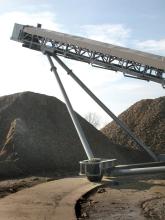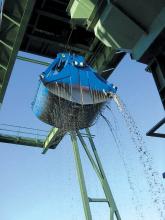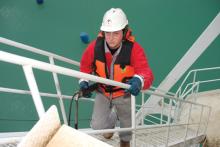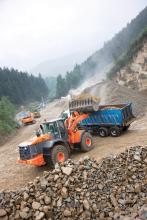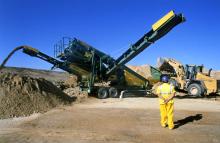
Like most countries the economic crisis has hit construction in Greece and with it the aggregates industry, though things are holding for the moment reports Adrian Greeman.
Mountainous terrain and dry summers mean that Greece is relatively short of the long rivers and the flat lowlands where gravel deposits are found. But far from this being a problem for the aggregate industry it has been an advantage.
Quarried crushed rock, technically more suitable for concrete making than rounded river deposits, is almost exclusively the output both for direct use in concrete and for input into cement making. River won aggregate and deposits constitute no more than 10% of production.
Demand
There has been plenty of demand for aggregate in Greece. A thriving tourist industry and an economy that has grown considerably in the last two decades, with
Construction techniques used in Greece mean that these projects are nearly always built with concrete. Greece's small population, which is a bit under 10 million, combined with a predominantly agricultural pre-war economy means that the country does not have its own steel industry and it makes economic sense to use concrete.
Geology
Fortunately there is plenty of raw material for both cement production and the aggregates for concrete. Greece's geology is possible one of the most complicated in the world, featuring a jumble of seismically disturbed tectonic plates and overlain thrust plates with fault lines and sudden transitions everywhere, all complicated by metamorphic transformations and volcanic intrusions.
But there is one overriding feature, which is that most of the rock is carboniferous explained Professor Ananias Tsiramadis at the School of Geology at Thessalonika's Aristotle University. "Perhaps 75% is either limestone or dolomites and sometimes marble," he said.
The bulk of Greece's mainland is an ancient seabed with multiple thick layers of predominantly marine deposits which have been thrust to the surface by the same tectonic collision which formed the European Alps. The tectonic action also produced volcanic activity in the south, most famously the explosive detonation of the island of Thera 3000 years ago. Some special minerals have resulted, such as the clay bentonite found in Milos island and used widely in construction for tunnelling and foundations. Greece is the world's third largest producer of this specialist material.
Normal rock extraction is scattered throughout Greece, and quarries used to be opened near to where the aggregates were needed due to transport being a major cost and that limits distances.
"In Greece most aggregate is delivered by truck," said Christos Kavalopoulos, the director general of the Association of Greek Mining Enterprises, the body which represents both specialist mineral companies and aggregate extractors in the country. "Typically distances are around 15-30km from source though sometimes a little further, even as much as 80km in some cases." There is a certain amount of sea delivery though this is mostly only within the various island archipelagos where demand is relatively limited and infrequent or sporadic. "Quite often there will be one quarry serving an island group," said Kavalopoulos. "There is virtually no export or import to speak of." According to Kavalopoulos, much of the industry is local and family owned, with enterprises usually having one or two quarries and rarely exceeding around 24ha of land used for quarrying. A very small additional amount of production comes from the strip cover of open cast mines as a by-product.
"There are also bigger companies operating, particularly those like the
According to Lafarge quarry development manager Kyriakos Assimakopoulos, the number peaked in 2007 and has fallen back somewhat to a bit over 90million tonnes last year. Assimakopoulos has predicted that this is projected to fall to 85million tonnes this year.
Most of Greece's quarries produce around 0.5million tonnes on average but there are a small number of large quarries producing up to 6million tonnes annually. "Three of our large quarries are in the south and we have one in the north," said Assimakopoulos. "Around 30million tonnes of the total goes into cement." As well as the normal limestone quarries there are a few extracting harder metamorphic and volcanic rocks, added Tsiramadis. These are located in the north east and around Thrace where there are outcrops of andesite and serpentinite which are useful for asphalt production, particularly for hard wearing courses. A certain amount of limestone also goes into asphalt though it is not a major proportion.
EU investment
The economic crisis has taken its toll on the construction industry, especially with a very slow market for apartments and houses at present. Around 150,000 units remain unsold in Greece, so few new developments are getting started.
Production has been held up to some extent by continuing public works projects. "The normal ratio of 60% private sector work to 40% public is reversed at present," said Assimakopoulos. Schemes such at as the Athens metro are currently seeing extensions and there is highway work in the north, and construction for a metro line for Thessalonika is just starting.
Kavalopoulos thinks that the fairly severe drop in output early this year is tailing off and the market may stabilise by the end of the year.
Public schemes, sometimes aided by EU money, have been important for the last 15 years, not least for the long Egnatia motorway scheme running some 600km from the port of Igoumenitsa on the west coast to the Turkish border in the East.
To some extent this explains why the industry is not as concentrated around Athens as might be expected in a country where over half the population, about 6million people, live in the capital or at least the greater Athens area. "About 14% is around Athens, and another 10% around Thessalonika. Another 7% is in Crete, the largest island and about 8% in the Magnesia region. The rest is distributed," said Assimakopoulos.
There have been changes in the industry meanwhile. As everywhere, environmental pressures have grown stronger and reluctance to have quarries "in my back yard" affects smaller communities and towns. Local concern is reinforced by tourism considerations.
Over 20 years ago a zoning system was introduced by central government whereby the local prefectures had to set aside certain land for extraction while eliminating quarries elsewhere. "Around Athens a number of major quarries have closed on the western side and there are only about four big ones left now," said Assimakopoulos.
Permitting is a complex business, according to both Assimakopoulos and Kavalopoulos. After acquiring land ownership and planning rights, there is a set of hoops to go through to get environmental permissions, production permission and even archaeological permission. The last is not often as difficult as might be expected in a country laden with ancient remnants but if something is discovered the ministry in question has draconian powers to stop operations. Licences are for forty years, but only within the quarry zones, and environmental assessments are required every seven years.
A number of quarries, perhaps around 15%, work on a "semi-legal basis" according to Assimakopoulos. "There are various ways around the law such as using the three or four year grace period for remediation to continue production," he said.
As everywhere remedial works are required and finance must be set aside to ensure it can be done when applications are made. Greece as a dry country sees less of the landscaped lakes that are usually developed elsewhere in Europe but it has its own speciality - the renovation of a quarry pit into a local outdoor theatre space or amphitheatre.

